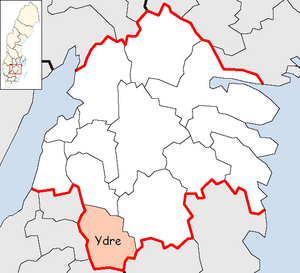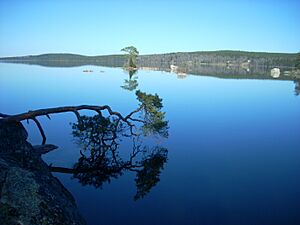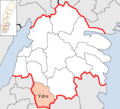Ydre Municipality facts for kids
Quick facts for kids
Ydre Municipality
Ydre kommun
|
||
|---|---|---|
 |
||
|
||
 |
||
| Country | Sweden | |
| County | Östergötland County | |
| Seat | Österbymo | |
| Area | ||
| • Total | 782.65 km2 (302.18 sq mi) | |
| • Land | 679.03 km2 (262.17 sq mi) | |
| • Water | 103.62 km2 (40.01 sq mi) | |
| Area as of January 1, 2010. | ||
| Population
(June 30, 2012)
|
||
| • Total | 3,665 | |
| • Density | 4.6828/km2 (12.1284/sq mi) | |
| Time zone | UTC+1 (CET) | |
| • Summer (DST) | UTC+2 (CEST) | |
| ISO 3166 code | SE | |
| Province | Östergötland | |
| Municipal code | 0512 | |
| Website | www.ydre.se | |
Ydre Municipality (called Ydre kommun in Swedish) is a local government area in Östergötland County, located in southeast Sweden. The main town and administrative center of the municipality is Österbymo.
This municipality was formed in 1952. It brought together six smaller areas into one larger unit. The name "Ydre" comes from an old historical region called the Ydre Hundred. The size of the municipality has stayed the same since 1971.
The name Ydre likely means "place of yews". Yews are a type of evergreen tree. Some places, like Idhult and Idebo, are especially linked to these trees.
Contents
Towns and Villages in Ydre Municipality
Ydre Municipality has three main urban areas, also known as tätorter or localities. These are towns or villages where people live close together.
The table below lists these places by how many people lived there on December 31, 2005. The main town, which is the municipal seat, is shown in bold.
| # | Locality | Population |
|---|---|---|
| 1 | Österbymo | 873 |
| 2 | Hestra | 490 |
| 3 | Rydsnäs | 304 |
Other smaller villages and communities in Ydre include Sund, Torpa, Norra Vi, Asby, Rönnäs, Svinhult, and Ydrefors.
Climate and Nature in Ydre
Compared to other parts of southern Sweden, Ydre often has less rain and lower humidity. The months with the most rain are September, July, and August, each getting about 70 millimeters. February and March are the driest months, with about 35 millimeters of rain each.
The warmest months are July, June, and August, with average temperatures around 14–15 °C. The coldest months are January and February, with temperatures around -4 °C. Experts believe the climate here will become warmer and drier in the future.
Plants and Trees of Ydre
The time when plants can grow, called the growing season, around Lake Sommen lasts about 216 days. Most of the plants in Ydre are pine and spruce forests. You can also find broad-leaf forests and farm fields in some areas.
The southern shores of Lake Sommen have more lush plants and broad-leaf trees. The northern side has more cliffs and continuous pine forests. A rare and endangered flower called Anthericum liliago grows along the rocky shores of the lake. This is one of the most northern places where it can be found.
On Torpön island, you can find Sweden's largest wych elm tree. Near Asby, a few kilometers from the southern shores, grows Sweden's thickest spruce tree. The name Ydre, which used to describe most of the area around Sommen, means "place of yews". The village of Idebo, near Norra Vifjärden, is especially connected to yew trees.
Some plants that usually grow in areas with carbonate rock are rarely found near Sommen. This is surprising because there are no known carbonate rock areas here. These plants include Vicia pisiformis and the orchids Ophrys myoides, Malaxis monophyllos, and Herminium monorchis.
History of Ydre Municipality
Old Tales and Early Christianity
There are many old stories about jättar (giants) and trolls who tried to stop Christianity from spreading in Ydre. It is thought that church building followed a tradition where the king would start the building, and then local people would finish it. This rule was later written down in a law called Östgötalagen.
We don't know exactly when the first churches around Lake Sommen were built. For example, the church in nearby Tidersrum was built around 1300. Some historians believe the church in Sund was built in the 12th century.
The Reformation and Wars
During the Dacke War in 1542, Nils Dacke and his army moved north through Ydre. Local priests from Sund and Asby, and the people in general, supported Dacke's rebellion. They were unhappy with the church changes made by King Gustav Vasa. The priests of Sund and Norra Vi even encouraged the uprising.
However, a local nobleman named Måns Johansson Natt och Dag, who owned the Ringshult manor, sided with the king. He was put in charge of an army to stop the rebellion. Dacke's troops continued north, reaching as far as Mjölby. The area around Lake Sommen was mostly safe from the fighting. Some small battles did happen near Kisa, which is tens of kilometers northeast of Sommen.
Even after Dacke died, unrest continued in Ydre. It only stopped when King Gustav Vasa sent 400 soldiers to calm the area. Despite earlier supporting Catholicism, church leaders from Ydre voted to adopt the Lutheran creed at the Uppsala Synod in 1593.
Places to Visit in Ydre
Ydre has some interesting places to see. At least two churches have very old foundations from the Middle Ages: the Church of Asby in Asby, and the Church of Torpa in the countryside. There is also a beautiful church from the 18th century, the Church of Norra Vi, which is right by Lake Sommen.
Another popular place to visit is Naturum Sommen on Torpön Island. This is a visitor center and a natural history museum where you can learn about the local nature.
Images for kids
See also
 In Spanish: Municipio de Ydre para niños
In Spanish: Municipio de Ydre para niños







